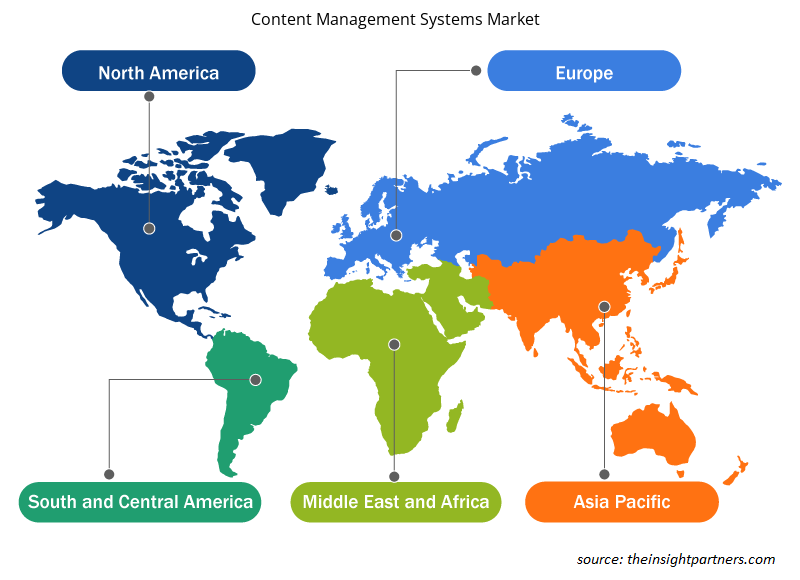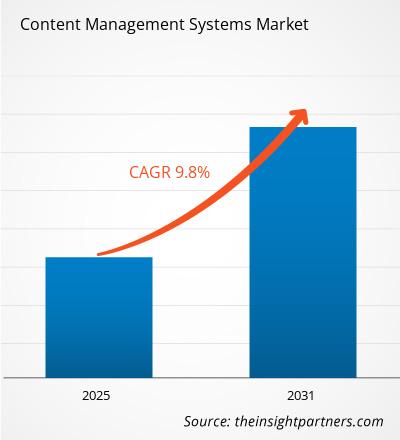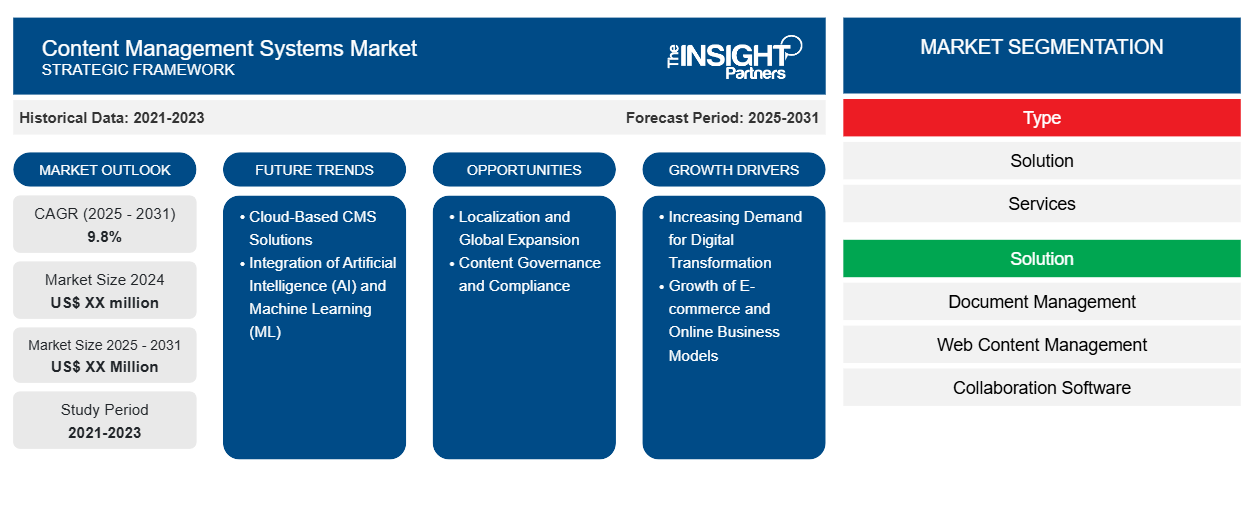Se espera que el mercado de sistemas de gestión de contenido registre una CAGR del 9,8 % entre 2024 y 2031, con un tamaño de mercado que se expandirá de US$ XX millones en 2024 a US$ XX millones en 2031.
El informe está segmentado por tipo (solución, servicios), solución (gestión de documentos, gestión de contenido web, software de colaboración, gestión de derechos digitales, análisis de contenido, otros), implementación (nube, local), uso final (BFSI, gobierno y sector público, atención médica, TI y telecomunicaciones, comercio minorista y comercio electrónico, otros). El análisis global se desglosa aún más a nivel regional y por países principales. El informe ofrece el valor en USD para el análisis y los segmentos anteriores.
Propósito del Informe
El informe Content Management System Market de The Insight Partners tiene como objetivo describir el panorama actual y el crecimiento futuro, los principales factores impulsores, los desafíos y las oportunidades. Esto proporcionará información a diversas partes interesadas del negocio, como:
- Proveedores/fabricantes de tecnología: Para comprender la dinámica cambiante del mercado y conocer las oportunidades potenciales de crecimiento, lo que les permitirá tomar decisiones estratégicas informadas.
- Inversionistas: Realizar un análisis exhaustivo de tendencias sobre la tasa de crecimiento del mercado, las proyecciones financieras del mercado y las oportunidades que existen en toda la cadena de valor.
- Órganos reguladores: Regular las políticas y vigilar las actividades del mercado con el objetivo de minimizar los abusos, preservar la confianza de los inversores y defender la integridad y estabilidad del mercado.
Segmentación del mercado de sistemas de gestión de contenidos
Tipo
- Solución
- Servicios
Solución
- Gestión de documentos
- Gestión de contenido web
- Software de colaboración
- Gestión de derechos digitales
- Análisis de contenido
- Otros
Despliegue
- Nube
- En las instalaciones
Uso final
- BFSI
- Gobierno y sector público
- Cuidado de la salud
- TI y telecomunicaciones
- Comercio minorista y comercio electrónico
- Otros
Personalice este informe según sus necesidades
Obtendrá personalización en cualquier informe, sin cargo, incluidas partes de este informe o análisis a nivel de país, paquete de datos de Excel, así como también grandes ofertas y descuentos para empresas emergentes y universidades.
-
Obtenga las principales tendencias clave del mercado de este informe.Esta muestra GRATUITA incluirá análisis de datos, desde tendencias del mercado hasta estimaciones y pronósticos.
Factores impulsores del crecimiento del mercado de sistemas de gestión de contenidos
- Demanda creciente de transformación digital: a medida que las organizaciones de todos los sectores se someten a una transformación digital, ha aumentado la necesidad de soluciones de gestión de contenido eficientes. Las plataformas CMS permiten a las empresas gestionar, crear y distribuir contenido sin problemas a través de varios canales digitales. La creciente tendencia de trasladar las operaciones a Internet y mejorar las experiencias digitales es un factor clave para el mercado de CMS.
- Crecimiento del comercio electrónico y los modelos de negocio online: con la rápida expansión del comercio electrónico, las empresas están invirtiendo fuertemente en plataformas CMS para agilizar la gestión de contenido de productos, mejorar la experiencia del cliente y optimizar las estrategias de marketing digital. Las soluciones CMS permiten una mejor gestión del inventario, la entrega de contenido personalizado y una integración eficiente con otras plataformas de comercio electrónico, lo que impulsa el crecimiento del mercado.
Tendencias futuras del mercado de sistemas de gestión de contenidos
- Soluciones CMS basadas en la nube: la computación en la nube continúa revolucionando el panorama de los CMS. Las plataformas CMS basadas en la nube ofrecen escalabilidad, flexibilidad y rentabilidad en comparación con las soluciones locales tradicionales. La adopción de CMS en la nube está aumentando debido a su capacidad para respaldar la distribución de contenido global, la colaboración fluida y los costos reducidos de mantenimiento de la infraestructura.
- Integración de inteligencia artificial (IA) y aprendizaje automático (ML): la IA y el ML se están integrando cada vez más en las plataformas CMS para mejorar la gestión de contenido. La IA ayuda a automatizar el etiquetado de contenido, mejorar las capacidades de búsqueda, brindar recomendaciones de contenido personalizadas y analizar el comportamiento del usuario para obtener mejores estrategias de contenido. A medida que avanza la tecnología de IA, las soluciones CMS se vuelven más inteligentes e intuitivas.
Oportunidades de mercado para sistemas de gestión de contenidos
- Localización y expansión global: A medida que las empresas buscan expandir su alcance a nivel mundial, la localización de contenido se convierte en un factor crítico. Las soluciones CMS pueden ofrecer traducción automática, herramientas de localización y soporte multilingüe, lo que permite a las empresas adaptar su contenido a diferentes regiones e idiomas, ampliando así su alcance de mercado y mejorando la interacción con los clientes a escala global.
- Cumplimiento y gobernanza de contenido: con regulaciones de protección de datos más estrictas como GDPR y CCPA, las empresas buscan cada vez más soluciones CMS que puedan garantizar el cumplimiento y la gobernanza de contenido. Las plataformas CMS pueden ayudar a automatizar los flujos de trabajo de cumplimiento, proporcionar registros de auditoría y hacer cumplir las políticas de contenido, lo que presenta una oportunidad importante para los proveedores que ofrecen funciones sólidas de gobernanza de contenido.
Perspectivas regionales del mercado de sistemas de gestión de contenido
Los analistas de Insight Partners explicaron en detalle las tendencias y los factores regionales que influyen en el mercado de sistemas de gestión de contenido durante el período de pronóstico. Esta sección también analiza los segmentos y la geografía del mercado de sistemas de gestión de contenido en América del Norte, Europa, Asia Pacífico, Oriente Medio y África, y América del Sur y Central.

- Obtenga datos regionales específicos para el mercado de sistemas de gestión de contenido
Alcance del informe de mercado de sistemas de gestión de contenido
| Atributo del informe | Detalles |
|---|---|
| Tamaño del mercado en 2024 | XX millones de dólares estadounidenses |
| Tamaño del mercado en 2031 | US$ XX millones |
| CAGR global (2024 - 2031) | 9,8% |
| Datos históricos | 2021-2023 |
| Período de pronóstico | 2025-2031 |
| Segmentos cubiertos |
Por tipo
|
| Regiones y países cubiertos |
América del norte
|
| Líderes del mercado y perfiles de empresas clave |
|
Densidad de actores del mercado de sistemas de gestión de contenido: comprensión de su impacto en la dinámica empresarial
El mercado de sistemas de gestión de contenido está creciendo rápidamente, impulsado por la creciente demanda de los usuarios finales debido a factores como la evolución de las preferencias de los consumidores, los avances tecnológicos y una mayor conciencia de los beneficios del producto. A medida que aumenta la demanda, las empresas amplían sus ofertas, innovan para satisfacer las necesidades de los consumidores y aprovechan las tendencias emergentes, lo que impulsa aún más el crecimiento del mercado.
La densidad de actores del mercado se refiere a la distribución de las empresas o firmas que operan dentro de un mercado o industria en particular. Indica cuántos competidores (actores del mercado) están presentes en un espacio de mercado determinado en relación con su tamaño o valor total de mercado.
Las principales empresas que operan en el mercado de sistemas de gestión de contenidos son:
- Corporación Oracle
- Corporación OpenText
- Cisco Systems Inc
- Corporación IBM
- Corporación EMC
Descargo de responsabilidad : Las empresas enumeradas anteriormente no están clasificadas en ningún orden particular.

- Obtenga una descripción general de los principales actores clave del mercado de sistemas de gestión de contenido
Puntos de venta clave
- Cobertura integral: el informe cubre de manera integral el análisis de productos, servicios, tipos y usuarios finales del mercado del sistema de gestión de contenido, proporcionando un panorama holístico.
- Análisis de expertos: el informe se compila sobre la base de un profundo conocimiento de expertos y analistas de la industria.
- Información actualizada: El informe asegura relevancia comercial debido a su cobertura de información reciente y tendencias de datos.
- Opciones de personalización: este informe se puede personalizar para satisfacer los requisitos específicos del cliente y adaptarse adecuadamente a las estrategias comerciales.
Por lo tanto, el informe de investigación sobre el mercado de sistemas de gestión de contenido puede ayudar a abrir camino para descifrar y comprender el escenario de la industria y las perspectivas de crecimiento. Si bien puede haber algunas preocupaciones válidas, los beneficios generales de este informe tienden a superar las desventajas.
- Análisis histórico (2 años), año base, pronóstico (7 años) con CAGR
- Análisis PEST y FODA
- Tamaño del mercado, valor/volumen: global, regional y nacional
- Industria y panorama competitivo
- Conjunto de datos de Excel
Informes recientes
Informes relacionados
Testimonios
Razón para comprar
- Toma de decisiones informada
- Comprensión de la dinámica del mercado
- Análisis competitivo
- Información sobre clientes
- Pronósticos del mercado
- Mitigación de riesgos
- Planificación estratégica
- Justificación de la inversión
- Identificación de mercados emergentes
- Mejora de las estrategias de marketing
- Impulso de la eficiencia operativa
- Alineación con las tendencias regulatorias























 Obtenga una muestra gratuita para - Mercado de sistemas de gestión de contenidos
Obtenga una muestra gratuita para - Mercado de sistemas de gestión de contenidos